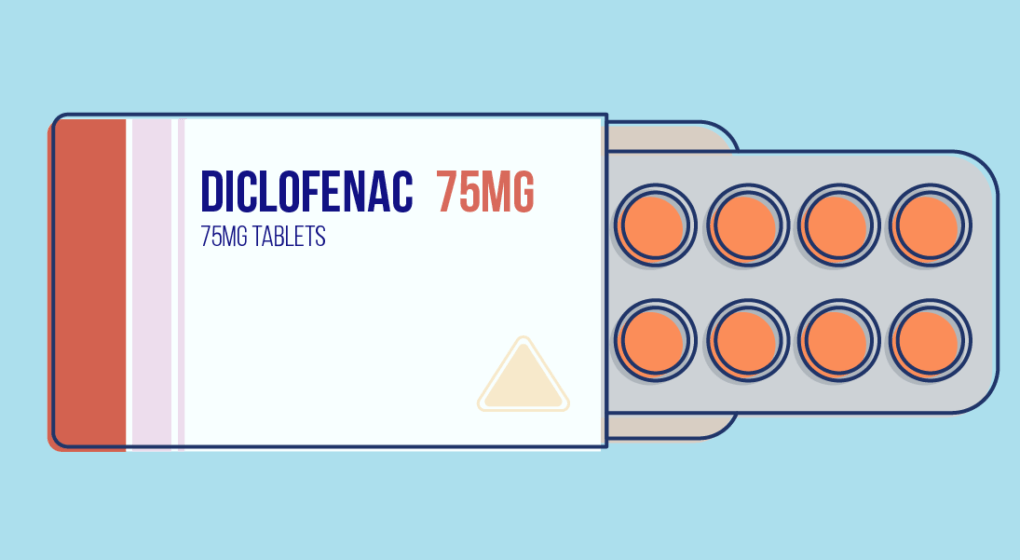
Diclofenac is a type of drug called a non-steroidal anti-inflammatory drug (NSAID). It works by stopping the production of compounds called prostaglandins in the body, which have a number of effects, including to cause inflammation.
As a result, diclofenac can help to reduce pain and inflammation by stopping the production of prostaglandins. This is why it is usually used to relieve painful inflammatory conditions, such as arthritis. It is also available as a cream so that it can be applied to the affected area, with less impact on the rest of the body.
Brand Names and Doses
Diclofenac is the generic name of the drug, which is the name of the active component that has an effect on your body. You may also know it better by a brand name, which is the name given to the medication made by each pharmaceutical company so that they can market it.
Brand names of Diclofenac for oral tablets or liquid include:
Clonac tablets (25 mg, 50 mg)
Fenac tablets (25 mg, 50 mg)
Imflac tablets (25 mg)
Viclofen tablets (25 mg)
Voltaren tablets (25 mg)
Voltaren Rapid tablets (12.5 mg, 25 mg, 50 mg)
Voltfast oral liquid powder (50 mg/sachet)
The brand name of Diclofenac for suppositories to be inserted in the rear end is Voltaren, which is available is several doses of 12.5mg, 25 mg, 50 mg and 100 mg.
Diclofenac is also available as a gel to be applied to the affected area of the body, which is useful for localized muscular injuries. Brand names of the diclofenac gel include Dencorub Anti-Inflammatory Gel, Voltaren Emulgel and Voltaren Osteo Gel.
What type of drug is it?
Diclofenac is a type of drug known as a non-steroidal anti-inflammatory drug (NSAID), which is a group of drugs that all work in a similar way. Other examples of NSAIDs include:
Diclofenac is a nonselective NSAID, which means that it blocks both COX-1 and COX-2 to stop the production of more types of prostaglandins than some other NSAIDs. This means that it is more likely to cause side effects due to the action of the other prostaglandins that is reduced.
It also has a relatively short half-life, which means that your body clears it quite quickly after you take a dose. As a result, virtually none of the drug will be left 4-6 hours after your last dose. This is a good thing for quick pain relief, but you will need to take regular doses (up to 3 per day) to maintain good pain relief.
What is Diclofenac used for?
Diclofenac can be used to help relieve symptoms of pain and inflammation caused by a variety of health conditions. Your doctor may recommend it for:
Rheumatoid arthritis
Osteoarthritis
Period pain
Post-surgery pain
Muscular injury pain
Actinic keratosis
Diclofenac is particularly useful pain and inflammation in soft tissues in your body because the gel can be applied exactly where it is needed. For example, if you have sprained your ankle or have a sore shoulder, you can apply the gel to the inflamed area so that the pain relief and anti-inflammatory effect is targeted towards that area.
How does it work?
Diclofenac works by inhibiting COX-1 and COX-2, which are needed to produce the different prostaglandins in your body.
You have many different types of prostaglandins in your body, and there are some in almost every tissue of your body. They each have different effects, such as to cause:
the tissues in your body to become inflamed
your blood vessels to relax and widen
the platelets in your blood to come together to form a clot
Diclofenac has a general effect on almost all the prostaglandins because it blocks both COX-1 and COX-2 from producing prostaglandins in your body. This means that it can reduce all of the usual effects prostaglandins. We want it to reduce inflammation because that is why we are using it, but it can also cause hypertension and affect the way the blood forms clots.
Side Effects
There are many different side effects that you may experience if you are taking diclofenac. These do not affect everyone, but it’s important to know what they are so that you can recognize them if you do notice them.
The side effects of Diclofenac may include:
Nausea
Heartburn (dyspepsia)
Diarrhea
Headache
Dizziness
Gastrointestinal ulcers
Gastrointestinal bleeding
Hypertension
This is not a complete list of side effects, but just some of the most common. Please see the diclofenac information leaflet for more detailed information.
Many of these side effects can be reduced if you use the gel instead of the oral tablet. This is because the effect occurs mainly in the affected area, instead of the rest of the body.
Drug Interactions
Diclofenac can interact with many other medications when they are used in together, including:
Aldosterone antagonists
Alendronate
Brimonidine
Calcineurin inhibitors
Corticosteroids
Cyclosporin
Fluconazole
Lithium
Loop diuretics
Methotrexate
Phenindione
Potassium
Prostaglandin analogues
Rifampicin
Tacrolimus
Thiazide diuretics
Thiazolidinediones
Triamterene
Warfarin
These medications can often be used together, but your doctor should be aware that you are taking both medications so that they can adjust the dose as needed to ensure they are safe and effective.
Cautions
There are some people who may need to avoid using Diclofenac, or use it with caution, because they may be at risk of side effects due to the medication.
Peptic ulcers or GI bleeding:
Coagulation disorders:
Cardiovascular disease:
Asthma:
Inflammatory Bowel Disease (IBD):
Renal Impairment
Pregnancy and Breastfeeding
Diclofenac is not usually recommended for women who are pregnant or trying to conceive. This is because it can interfere with fertility and the development of the fetus.
For women planning to become pregnant, it can prevent or delay ovulation, so that the woman is less likely to conceive. Additionally, using diclofenac during pregnancy, particularly at the time of conception, is linked to a higher risk of miscarriage. It may also cause other problems later on in the pregnancy and should be avoided.
For women who are breastfeeding, diclofenac is considered safe to use.
Pin it!


